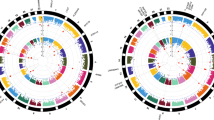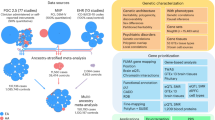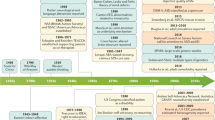Abstract
Background
Attention-deficit hyperactivity disorder (ADHD) is diagnosed in ~7% of school-aged children. The role of endocrine-disrupting chemicals (EDC) and oxidative stress in ADHD etiology are not clear.
Objective
Assessment of the associations between simultaneous exposure to multiple compounds and ADHD in children.
Methods
The case-control study included 76 clinically diagnosed ADHD cases and 98 controls, aged 4–15 years old. Concentrations quartiles of urinary metabolites of acrylamide, acrolein, nonylphenol, phthalates, and organophosphate pesticides and biomarkers of oxidative stress were used to fit logistic regressions for each compound and weighted quantiles sum (WQS) regression for the mixture.
Results
Positive dose-response relationships with ADHD were observed for 4-hydroxy-2-nonenal-mercapturic acid (HNE-MA) (odds ratio(OR)Q4 = 3.73, 95%CI [1.32, 11.04], ptrend = 0.003), dimethyl phosphate (DMP) (ORQ4 = 4.04, 95%CI [1.34, 12.94], ptrend = 0.014) and diethyl phosphate (ORQ4 = 2.61, 95%CI = [0.93, 7.66], ptrend = 0.030), and for the mixture of compounds (ORWQS = 3.82, 95%CI = [1.78, 8.19]) with the main contributions from HNE-MA (28.9%) and DMP (18.4%).
Conclusions
The dose-response relationship suggests enhanced susceptibility to EDC burden in children even at lower levels, whereas the main risk is likely from organophosphate pesticides. HNE-MA is recommended as a sensitive biomarker of lipid peroxidation in the further elucidation of the oxidative stress role in ADHD etiology.
This is a preview of subscription content, access via your institution
Access options
Subscribe to this journal
Receive 6 print issues and online access
$259.00 per year
only $43.17 per issue
Buy this article
- Purchase on Springer Link
- Instant access to full article PDF
Prices may be subject to local taxes which are calculated during checkout



Similar content being viewed by others
References
Thomas R, Sanders S, Doust J, Beller E, Glasziou P. Prevalence of attention-deficit/hyperactivity disorder: a systematic review and meta-analysis. Pediatrics. 2015;135:e994–1001.
American Psychiatric Association. Diagnostic and statistical manual of mental disorders 5th ed. Washington DC 2013.
Sharma A, Couture J. A review of the pathophysiology, etiology, and treatment of attention-deficit hyperactivity disorder (ADHD). Ann Pharmacother. 2014;48:209–25.
Nilsen FM, Tulve NS. A systematic review and meta-analysis examining the interrelationships between chemical and non-chemical stressors and inherent characteristics in children with ADHD. Environ Res. 2020;180:108884.
Froehlich TE, Anixt JS, Loe IM, Chirdkiatgumchai V, Kuan L, Gilman RC. Update on environmental risk factors for attention-deficit/hyperactivity disorder. Curr Psychiatry Rep. 2011;13:333–44.
Joseph N, Zhang-James Y, Perl A, Faraone SV. Oxidative stress and ADHD: a meta-analysis. J Atten Disord. 2015;19:915–24.
Alvarez-Arellano L, Gonzalez-Garcia N, Salazar-Garcia M, Corona JC. Antioxidants as a potential target against inflammation and oxidative stress in attention-deficit/hyperactivity disorder. Antioxidants (Basel). 2020;9.
Wu C, Chen ST, Peng KH, Cheng TJ, Wu KY. Concurrent quantification of multiple biomarkers indicative of oxidative stress status using liquid chromatography-tandem mass spectrometry. Anal Biochem. 2016;512:26–35.
Chang CH, Yu CJ, Du JC, Chiou HC, Chen HC, Yang W, et al. The interactions among organophosphate pesticide exposure, oxidative stress, and genetic polymorphisms of dopamine receptor D4 increase the risk of attention deficit/hyperactivity disorder in children. Environ Res. 2018;160:339–46.
Verlaet AAJ, Breynaert A, Ceulemans B, De Bruyne T, Fransen E, Pieters L, et al. Oxidative stress and immune aberrancies in attention-deficit/hyperactivity disorder (ADHD): a case-control comparison. Eur Child Adolesc Psychiatry. 2019;28:719–29.
Ceylan M, Sener S, Bayraktar AC, Kavutcu M. Oxidative imbalance in child and adolescent patients with attention-deficit/hyperactivity disorder. Prog Neuropsychopharmacol Biol Psychiatry. 2010;34:1491–4.
Oztop D, Altun H, Baskol G, Ozsoy S. Oxidative stress in children with attention deficit hyperactivity disorder. Clin Biochem. 2012;45:745–8.
Bellanger M, Demeneix B, Grandjean P, Zoeller RT, Trasande L. Neurobehavioral deficits, diseases, and associated costs of exposure to endocrine-disrupting chemicals in the European Union. J Clin Endocrinol Metab. 2015;100:1256–66.
Lin C-Y, Lee H-L, Chen Y-C, Lien G-W, Lin L-Y, Wen L-L, et al. Positive association between urinary levels of 8-hydroxydeoxyguanosine and the acrylamide metabolite N-acetyl-S-(propionamide)-cysteine in adolescents and young adults. J Hazard Mater. 2013;261:372–7.
Lin CY, Chen PC, Hsieh CJ, Chen CY, Hu A, Sung FC, et al. Positive association between urinary concentration of phthalate metabolites and oxidation of DNA and lipid in adolescents and young adults. Sci Rep. 2017;7:44318.
Huang P-C, Waits A, Chen H-C, Chang W-T, Jaakkola JJ, Huang H-B. Mediating role of oxidative/nitrosative stress biomarkers in the associations between phthalate exposure and thyroid function in Taiwanese adults. Environ Int. 2020;140:105751.
Rohlman DS, Ismail A, Bonner MR, Abdel Rasoul G, Hendy O, Ortega Dickey L, et al. Occupational pesticide exposure and symptoms of attention deficit hyperactivity disorder in adolescent pesticide applicators in Egypt. Neurotoxicology. 2019;74:1–6.
Yu C-J, Du J-C, Chiou H-C, Chung M-Y, Yang W, Chen Y-S, et al. Increased risk of attention‐deficit/hyperactivity disorder associated with exposure to organophosphate pesticide in Taiwanese children. Andrology. 2016;4:695–705.
van Wendel de Joode B, Mora AM, Lindh CH, Hernández-Bonilla D, Córdoba L, Wesseling C, et al. Pesticide exposure and neurodevelopment in children aged 6–9 years from Talamanca, Costa Rica. Cortex. 2016;85:137–50.
Bouchard MF, Bellinger DC, Wright RO, Weisskopf MG. Attention-deficit/hyperactivity disorder and urinary metabolites of organophosphate pesticides. Pediatrics 2010;125:e1270–e7.
Radke EG, Braun JM, Nachman RM, Cooper GS. Phthalate exposure and neurodevelopment: a systematic review and meta-analysis of human epidemiological evidence. Environ Int. 2020;137:105408.
Lu Y-Y, Chen M-L, Sung F-C, Wang PS-G, Mao I-F. Daily intake of 4-nonylphenol in Taiwanese. Environ Int. 2007;33:903–10.
Masuo Y, Morita M, Oka S, Ishido M. Motor hyperactivity caused by a deficit in dopaminergic neurons and the effects of endocrine disruptors: a study inspired by the physiological roles of PACAP in the brain. Regulatory Pept. 2004;123:225–34.
Yu C-J, Du J-C, Chiou H-C, Yang S-H, Liao K-W, Yang W, et al. Attention deficit/hyperactivity disorder and urinary nonylphenol levels: a case-control study in Taiwanese Children. PLoS ONE. 2016;11.
Semla M, Goc Z, Martiniakova M, Omelka R, Formicki G. Acrylamide: a common food toxin related to physiological functions and health. Physiol Res. 2017;66:205–17.
Moghe A, Ghare S, Lamoreau B, Mohammad M, Barve S, McClain C, et al. Molecular mechanisms of acrolein toxicity: relevance to human disease. Toxicol Sci. 2015;143:242–55.
Kawatani M, Tsukahara H, Mayumi M. Evaluation of oxidative stress status in children with pervasive developmental disorder and attention deficit hyperactivity disorder using urinary-specific biomarkers. Redox Rep. 2011;16:45–6.
Erkekoglu P, Baydar T. Acrylamide neurotoxicity. Nutr Neurosci. 2014;17:49–57.
Yousef MI, El-Demerdash FM. Acrylamide-induced oxidative stress and biochemical perturbations in rats. Toxicology. 2006;219:133–41.
Catalgol B, Özhan G, Alpertunga B. Acrylamide-induced oxidative stress in human erythrocytes. Hum Exp Toxicol. 2009;28:611–7.
Rappaport SM, Smith MT. Environment and disease risks. Science. 2010;330:460–1.
Sille FCM, Karakitsios S, Kleensang A, Koehler K, Maertens A, Miller GW, et al. The exposome—a new approach for risk assessment. Altex. 2020;37:3–23.
Gau SSF, Shang CY, Liu SK, Lin CH, Swanson JM, Liu YC, et al. Psychometric properties of the Chinese version of the Swanson, Nolan, and Pelham, version IV scale–parent form. Int J Methods Psychiatr Res. 2008;17:35–44.
Eckert E, Schmid K, Schaller B, Hiddemann-Koca K, Drexler H, Göen T. Mercapturic acids as metabolites of alkylating substances in urine samples of German inhabitants. Int J Hyg Environ Health. 2011;214:196–204.
Carrico C, Gennings C, Wheeler DC, Factor-Litvak P. Characterization of weighted quantile sum regression for highly correlated data in a risk analysis setting. J Agric Biol Environ Stat. 2015;20:100–20.
Renzetti S, Curtin P, Just AC, Bello G, Gennings C. How to use gWQS package. 2021, May 20 [cited 2021 July 14]. In: The Comprehensive R Archive Network [Internet]. https://cran.r-project.org/web/packages/gWQS/vignettes/gwqs-vignette.html
Yu C-J, Du J-C, Chiou H-C, Feng C-C, Chung M-Y, Yang W, et al. Sugar-sweetened beverage consumption is adversely associated with childhood attention deficit/hyperactivity disorder. Int J Environ Res Public Health. 2016;13:678.
Rana J, Paul J. Health motive and the purchase of organic food: a meta‐analytic review. Int J Consum Stud. 2020;44:162–71.
Bulut M, Selek S, Gergerlioglu HS, Savas HA, Yilmaz HR, Yuce M, et al. Malondialdehyde levels in adult attention-deficit hyperactivity disorder. J Psychiatry Neurosci. 2007;32:435–8.
Bulut M, Selek S, Bez Y, Kaya MC, Gunes M, Karababa F, et al. Lipid peroxidation markers in adult attention deficit hyperactivity disorder: new findings for oxidative stress. Psychiatry Res. 2013;209:638–42.
Ito Y, Tomizawa M, Suzuki K, Shirakawa Y, Ono H, Adachi K, et al. Organophosphate agent induces ADHD-like behaviors via inhibition of brain endocannabinoid-hydrolyzing enzyme(s) in adolescent male rats. J Agric Food Chem. 2020;68:2547–53.
Leffa DT, Bellaver B, de Oliveira C, de Macedo IC, de Freitas JS, Grevet EH, et al. Increased oxidative parameters and decreased cytokine levels in an animal model of attention-deficit/hyperactivity disorder. Neurochem Res. 2017;42:3084–92.
Kuiper HC, Miranda CL, Sowell JD, Stevens JF. Mercapturic acid conjugates of 4-hydroxy-2-nonenal and 4-oxo-2-nonenal metabolites are in vivo markers of oxidative stress. J Biol Chem. 2008;283:17131–8.
Popa-Wagner A, Mitran S, Sivanesan S, Chang E, Buga AM. ROS and brain diseases: the good, the bad, and the ugly. Oxid Med Cell Longev. 2013;2013:963520.
Jaganjac M, Milkovic L, Gegotek A, Cindric M, Zarkovic K, Skrzydlewska E, et al. The relevance of pathophysiological alterations in redox signaling of 4-hydroxynonenal for pharmacological therapies of major stress-associated diseases. Free Rad Biol Med. 2019;157:128–53.
Ceylan MF, Sener S, Bayraktar AC, Kavutcu M. Changes in oxidative stress and cellular immunity serum markers in attention-deficit/hyperactivity disorder. Psychiatry Clin Neurosci. 2012;66:220–6.
Middlemore-Risher M-L, Buccafusco J, Terry A Jr. Repeated exposures to low-level chlorpyrifos results in impairments in sustained attention and increased impulsivity in rats. Neurotoxicology Teratol. 2010;32:415–24.
Elten M, Benchimol EI, Fell DB, Kuenzig ME, Smith G, Chen H, et al. Ambient air pollution and the risk of pediatric-onset inflammatory bowel disease: a population-based cohort study. Environ Int. 2020;138:105676.
Faraone SV, Perlis RH, Doyle AE, Smoller JW, Goralnick JJ, Holmgren MA, et al. Molecular genetics of attention-deficit/hyperactivity disorder. Biol Psychiatry. 2005;57:1313–23.
Acknowledgements
We would like to express our gratitude to the little patients of Taipei City Hospital, their parents, the medical and laboratory personnel, who devoted their time, efforts, and goodwill to make this study happen.
Funding
This study was financially supported by the Ministry of Science and Technology of the Republic of China (MOST 105-2314-B-010-019-, MOST107-2314-B-010-051-MY2) and the Department of Health, Taipei City Government (10301-62-004).
Author information
Authors and Affiliations
Corresponding author
Ethics declarations
Competing interests
The authors declare no competing interests.
Additional information
Publisher’s note Springer Nature remains neutral with regard to jurisdictional claims in published maps and institutional affiliations.
Supplementary information
Rights and permissions
About this article
Cite this article
Waits, A., Chang, CH., Yu, CJ. et al. Exposome of attention deficit hyperactivity disorder in Taiwanese children: exploring risks of endocrine-disrupting chemicals. J Expo Sci Environ Epidemiol 32, 169–176 (2022). https://doi.org/10.1038/s41370-021-00370-0
Received:
Revised:
Accepted:
Published:
Issue Date:
DOI: https://doi.org/10.1038/s41370-021-00370-0
Keyword
This article is cited by
-
Early childhood exposure to environmental phenols and parabens, phthalates, organophosphate pesticides, and trace elements in association with attention deficit hyperactivity disorder (ADHD) symptoms in the CHARGE study
Environmental Health (2024)
-
The Association of Bisphenol A and Parabens Exposure and Oxidative Stress in Attention-Deficit/Hyperactivity Disorder in Children and Adolescents
Exposure and Health (2024)
-
The susceptibility of humans to neurodegenerative and neurodevelopmental toxicities caused by organophosphorus pesticides
Archives of Toxicology (2023)
-
The association of bisphenol A and paraben exposure with sensorineural hearing loss in children
Environmental Science and Pollution Research (2023)
-
Urinary concentrations of fungicide carbendazim’s metabolite and associations with oxidative stress biomarkers in young children
Environmental Science and Pollution Research (2022)



